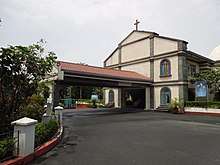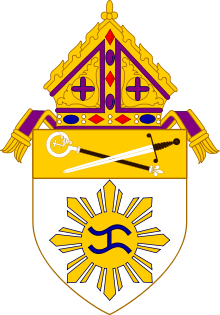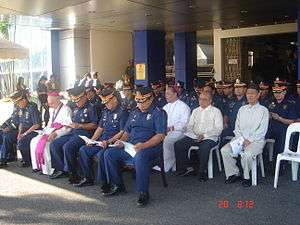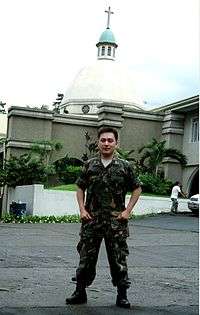Military Ordinariate of the Philippines
The Military Ordinariate of the Philippines or MOP is the military ordinariate of the Philippines[1] for the Armed Forces of the Philippines, Philippine National Police, and the Philippine Coast Guard. It has jurisdiction over all military, police and coast guard personnel, their dependents, and the civilian employees of all branches of the armed forces. Its titular patron is the Immaculate Conception, with SS. Ignatius of Loyola and John of Capistrano as secondary patrons. The Philippine military ordinary is the Most Rev. Oscar Jaime L. Florencio DD, a former auxiliary bishop of Cebu.
Military Ordinariate of the Philippines Ordinariatus Militaris Philippinensis Ordinaryato Militar ng Pilipinas | |
|---|---|
 Cathedral in Camp Aguinaldo | |
 Coat of arms | |
| Location | |
| Country | Philippines |
| Territory | |
| Headquarters | Camp Aguinaldo |
| Coordinates | 14.6116478°N 121.0585394°E |
| Statistics | |
| Churches | 3 |
| Information | |
| Denomination | Catholic |
| Sui iuris church | Latin Church |
| Rite | Roman Rite |
| Established | December 8, 1950 |
| Cathedral | Saint Ignatius Military Cathedral |
| Co-cathedral | Saint Joseph Pro-Cathedral Philippine National Police Shrine of Saint Therese of the Child Jesus Diocesan |
| Patron saint | Immaculate Conception Titular Ignatius of Loyola John of Capistrano |
| Current leadership | |
| Pope | Francis |
| Ordinary | Most Rev. Oscar Jaime L. Florencio DD |
| Vicar General | Very Rev. Msgr. Col. Albert C. Songco HP CHS |
History

The Military Ordinariate of the Philippines was initially erected as a Military Vicariate on December 8, 1950 as per decree by Pope Pius XII via the Consistoriat Decree Ad consulendum.[2] It was accepted by the Philippine Government in a diplomatic Agreement which took effect through the exchange of Notes Verbal in 1952[2] between then-Foreign Secretary Jaime Elizalde and the Papal Nuncio to the Philippines Archbishop Egidio Vagnozzi.[3] Rufino Jiao Santos, then-Auxiliary Bishop of Manila, took possession of the Vicariate and became the first Military Vicar in Philippine history.
On April 12, 1986, Pope John Paul II promulgated the Apostolic Constitution Spirituale militum curæ, which took effect on July 21, 1986. This Papal document was unique as it began a new structure for all Military Vicariates all over the world, elevating these to the level of Ordinariates, thus giving them the same status as territorial Dioceses.
The Ordinariate has its own curia and it exercises its pastoral ministry through Military, Police, and Philippine Coast Guard, Bureau of Jail Management and Penology,and Bureau of Fire Protection Chaplains assigned to the different branches of services of Filipino uniformed men and women. The exact number of faithful under this jurisdiction is a classified information, but it is approximately 90 percent of the servicemen and women.
The mostly Diocesan clergy of the Ordinariate carry officers' ranks, and are assigned to the different AFP, PNP, and Philippine Coast Guard, Bureau of Jail Management and Penology, and Bureau of Fire Protection command posts nationwide.
Jurisdiction
|
Subjects
- All Catholic Chaplains in active Military, Police, or Coast Guard service.
- All civilian Catholic priests, diocesan or religious, who are properly and officially appointed as Volunteer Chaplains in the service of the Military Ordinariate.
- All Catholic laity in active Military, Police, or Coast Guard service.
- All Catholic civilian employees, their spouses and children, residing either inside or outside any Military, Police, or Coast Guard installation.
- All families of Catholic laity in active Military, Police, or Coast Guard service; namely, the spouses, children, servants and those who habitually live in the same house, whether inside or outside any Military, Police, or Coast Guard installation.
- All Catholics living within any Military, Police, or Coast Guard installation, or in homes reserved by the Government for Military, Police, or Coast Guard personnel and their families.
- All Catholics living or working in military hospitals, hospices for the elderly, or similar institutions.
- All Catholics, whether or not members of a religious institute, who permanently carry out a task committed them by the Military Ordinary, or with his consent.[6]
Territorial possessions
Though not bound to any particular geographical area, the Military Ordinariate has several buildings under its jurisdiction, almost all of which are within military or police instalments. The Ordinariate's principal church is the Saint Ignatius Military Cathedral in Camp General Emilio Aguinaldo, Quezon City, Philippines, while its pro-cathedral for the Police is the Saint Joseph Pro-Cathedral in Camp Crame (across Camp Aguinaldo on the other side of EDSA).
The Ordinariate also owns the large Shrine of St. Therese, Doctor of the Church, situated near Villamor Airbase, NAIA Terminal 3, and Resorts World Manila in Pasay City.

Clergy
Chaplains
Priests who wish join the Chaplain Services of the Armed Forces, the National Police, and the Coast Guard are required to fulfil the standard requirements of both the service branch they are entering and the Church. The endorsement of the Military Ordinary is amongst the most important of the ecclesiastical requirements; the Ordinary submits the names of applicants for a "call to active duty" (CAD). He gives to Chaplains and civilian priests working for the services the canonical faculties to exercise their spiritual ministry among subjects of the Military Ordinariate.
Chaplains in active duty are given the initial rank of Captain or its equivalent in other branches of the services. They enjoy the progatives and privileges of the rest of the officers belonging to the same grade or rank in the service.
Chaplains in active service who are not incardinated into the Military Ordinariate may be subject to recall by the Bishop of their respective diocese of origin, even without cause. On the other hand, the Ordinary may also withdraw his endorsement for cause. The chaplain whose endorsement has thus been withdrawn is to report to their Diocesan Bishop or Religious Superior as soon as possible. Chaplains whose tour of active service is terminated are to return to their respective dioceses or religious orders, or as otherwise advised or directed by their original Bishop or Superior.
Non-combatant status
Military Ordinary
The Military Ordinary must be a Filipino-born member of the nation's Church hierarchy, and is appointed by the Holy See after consultation with government.[7] The Pope freely nominates the Military Ordinary– normally a bishop– or institutes or confirms the candidate legitimately chosen according to the Canon Law.[8] He belongs by right to the Catholic Bishops' Conference of the Philippines and is subject to the Congregation for Bishops.[9]
Former Military Ordinaries
- † Cardinal Rufino Jiao Santos (1951–1973) – Appointed as the Archbishop of Manila
- † Archbishop Mariano Gaviola (1974–1981) – Appointed as the Archbishop of Lipa
- † Bishop Pedro G. Magugat, MSC (1981–1985) – Died on February 26, 1995
- Archbishop Ramón Arguelles (1995–2004) – Appointed as the Archbishop of Lipa
- † Bishop Leopoldo S. Tumulak (2005–2017) – Died on June 17, 2017
- Bishop Oscar Jaime Florencio (2018–present)
See also
- Patron saints of the military
- Roman Catholicism in the Philippines
References
- For the definition and nature of a personal diocese or prelature pls cf. Code of Canon Law, Canons 294–297.
- Statutes of the Military Ordinariate of the Philippines Article II in Legislazione sugli Ordinariati Castrensi, Eduardo Baura, ed., Milano: Giuffrè Editore, 1992, p. 201.
- For the text of the documents regarding the Agreement cf. College of Law, University of the Philippines, Philippine Treaty Series: A collection of Texts of Treaties and other International Agreements to which the Philippines is a Party, Haydee B. Yorac, ed., Quezon City: 1968, Vol. II, pp. 793–796.
- Statutes of the Military Ordinariate of the Philippines Article III, Section 2.3 in Legislazione sugli Ordinariati Castrensi, Eduardo Baura, ed., Milano: Giuffrè Editore, 1992, Article III, Section 2.C, p. 203.
- Statutes of the Military Ordinariate of the Philippines Article III, Section 2.3 in Legislazione sugli Ordinariati Castrensi, Eduardo Baura, ed., Milano: Giuffrè Editore, 1992, pp.203–204.
- Statutes of the Military Ordinariate of the Philippines Article III, Section 3 in Legislazione sugli Ordinariati Castrensi, Eduardo Baura, ed., Milano: Giuffrè Editore, 1992, p. 205.
- "The Holy See shall entrust the office of the Military Vicar to a Filipino-born member of the Philippine hierarchy. However, before proceeding to his appointment, the Holy See shall communicate his name to the Philippine Government in order to ensure that there is no objection on the part of the said Philippine Government." Legislazione sugli Ordinariati Castrensi, Eduardo Baura, ed., Milano: Giuffrè Editore, 1992, p. 795.
- Cf. Code of Canon Law, Canon 377 para I.
- Statutes of the Military Ordinariate of the Philippines Article III, Section 2.3 in Legislazione sugli Ordinariati Castrensi, Eduardo Baura, ed., Milano: Giuffrè Editore, 1992, p. 202.
External links
- Military Ordinariate of the Philippines. Giga-Catholic Information (GCatholic.org). Retrieved 2010-08-20.
